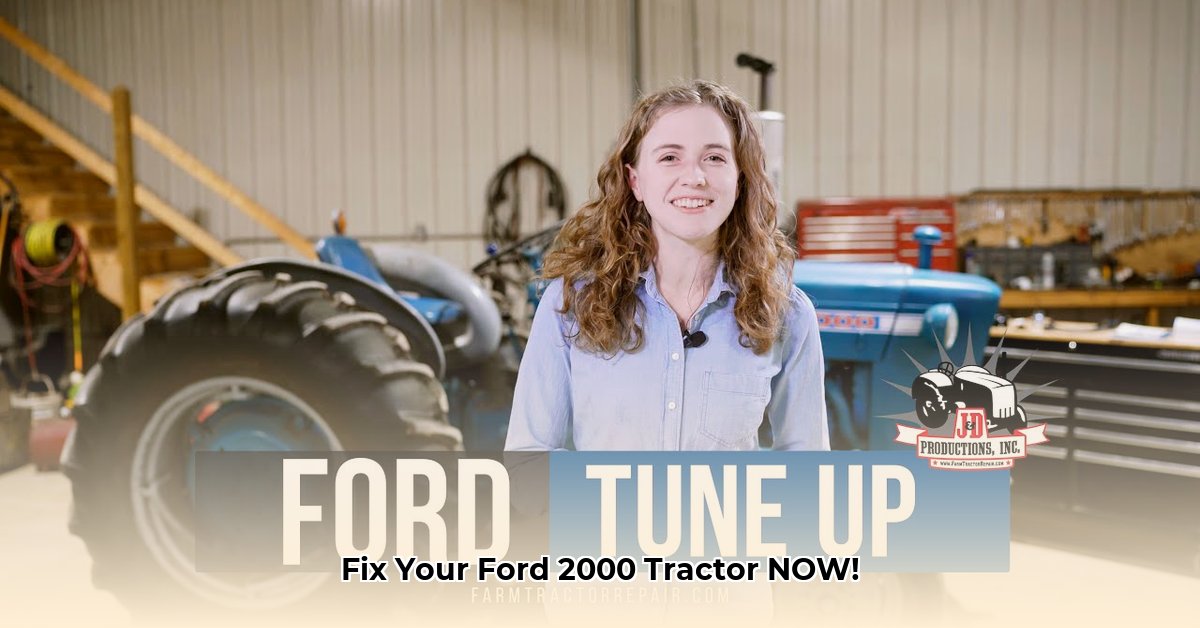
Ford 2000 Tractor Troubleshooting: A Comprehensive Guide
Owning a Ford 2000 tractor can be incredibly rewarding, but its age necessitates proactive maintenance and troubleshooting. This guide addresses common Ford 2000 problems, offering step-by-step solutions to get your tractor back to peak performance. Whether you're a seasoned mechanic or a weekend warrior, this guide provides actionable advice. For comfortable operation, consider upgrading your tractor seat.
Engine Troubles: Diagnosing and Fixing Starting and Performance Issues
Engine problems are frustrating, especially when fieldwork awaits. Let's tackle the most common issues:
Starting Problems: A Systematic Approach
Before disassembling anything, systematically check these:
- Fuel Level Check: Ensure the fuel tank isn't empty. (This surprisingly solves many problems).
- Fuel Line Inspection: Examine fuel lines for cracks, kinks, or obstructions. Replace damaged lines.
- Fuel Filter Check: A clogged fuel filter restricts fuel flow. Clean or replace the filter.
- Fuel Pump Performance Test: A weak fuel pump hinders fuel delivery. Check for unusual noises or, if necessary, conduct a pressure test (Consult your owner's manual).
- Carburetor/Injection System Examination: If the previous steps fail, consider professional help. Carburetor or injection system problems require specialized knowledge.
Beyond Starting: Addressing Other Engine Performance Problems
If your tractor starts but performs poorly, consider these possibilities:
- Low Compression: Loss of engine power suggests worn piston rings or valves. A compression test confirms this diagnosis. This typically necessitates professional repair.
- Engine Overheating: Check coolant levels and the radiator for blockages. Overheating signifies a serious issue requiring professional assessment.
Transmission Woes: Smoother Shifting Techniques
The Ford 2000's non-synchronized transmission presents unique challenges. Addressing this requires a methodical approach:
Shifting Difficulties: A Step-by-Step Guide
- Fluid Changes: Regular transmission fluid changes are vital for optimal performance. Always use the recommended fluid type and weight as specified in your owner's manual.
- Shift Linkage Adjustment: Ensure that the shift linkage is correctly adjusted and free from any binding.
- Clutch Adjustment: A properly adjusted clutch ensures smooth shifting. A slipping clutch indicates wear and necessitates repair.
- Internal Transmission Damage: Grinding noises during shifting clearly suggest internal transmission damage, usually requiring professional repair or a rebuild.
Hydraulic System Headaches: Maintaining Proper Fluid Flow
The Ford 2000's open-center hydraulic system is vulnerable to contamination, leading to various problems. Here's how to maintain your system:
Maintaining the Hydraulic System: Actionable Steps
- Fluid Changes: Regularly change the hydraulic fluid using the correct type specified in your owner's manual.
- Hose and Seal Inspections: Inspect hoses and seals regularly for leaks. Replace damaged components promptly.
- Hydraulic Pump Check: Low hydraulic pressure may indicate a failing pump. Professional assessment is advisable.
Electrical System Annoyances: Keeping the Lights On
Electrical problems, like battery issues and starter motor malfunctions, are common.
Troubleshooting Electrical Issues: A Practical Approach
- Battery Check: Check the battery's charge and clean corroded terminals. Replace a weak or faulty battery.
- Starter Motor Check: A slowly cranking engine or unresponsive starter suggests a faulty starter motor, requiring professional diagnosis.
- Wiring Harness Inspection: Inspect the wiring harness for damaged or loose wires. Repair or replace any damaged components.
Preventative Maintenance: The Key to Longevity
Preventative maintenance is your best strategy against costly repairs. Regular fluid changes and inspections extend the life of your Ford 2000.
Parts Sourcing: Locating Replacement Parts
Finding parts for a Ford 2000 may require some effort. Online retailers specializing in older tractor parts, local agricultural equipment suppliers, and experienced mechanics are valuable resources.
This guide provides a comprehensive starting point for troubleshooting common Ford 2000 problems. Remember, regular maintenance and prompt attention to minor issues will significantly extend your tractor's lifespan and minimize costly repairs.